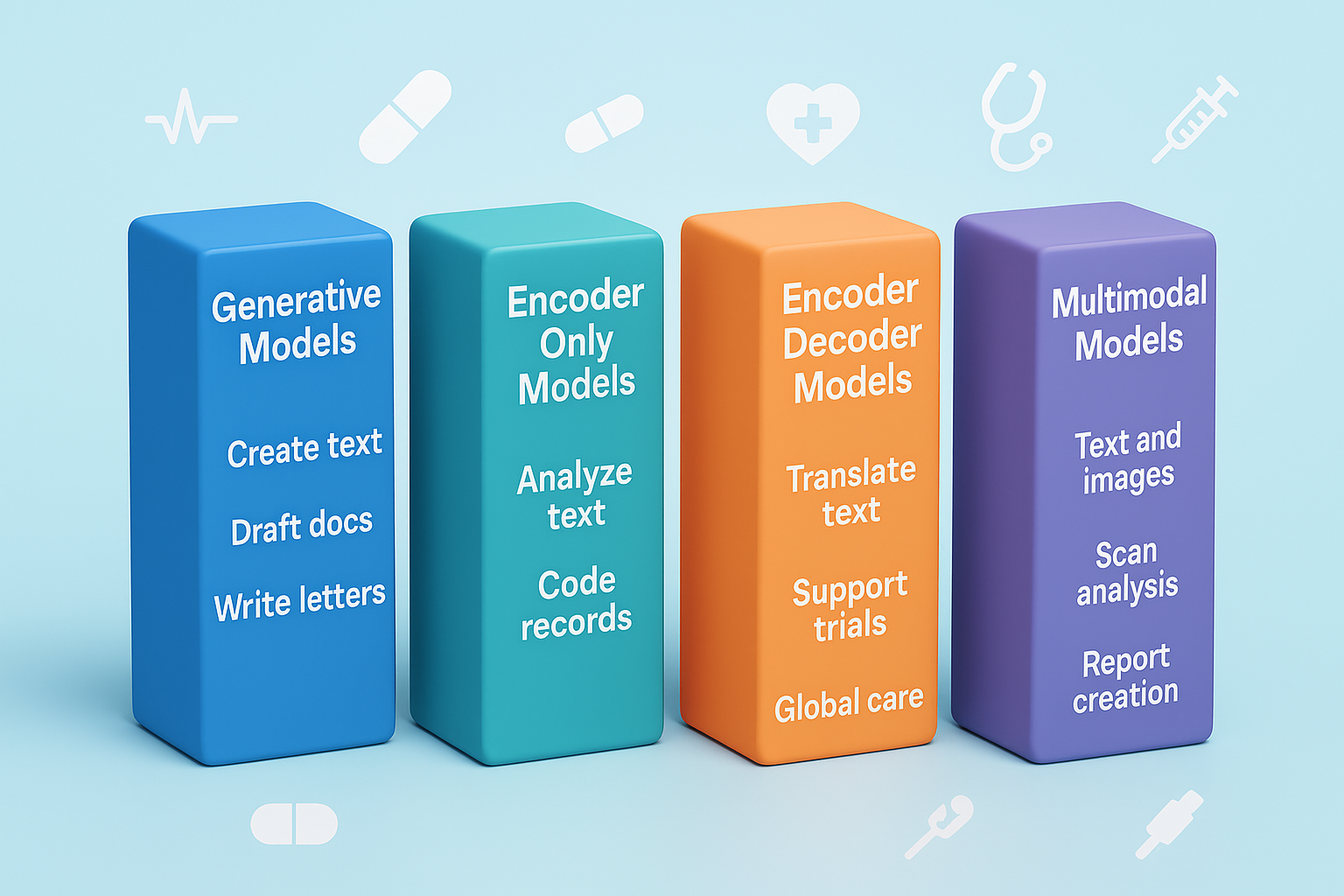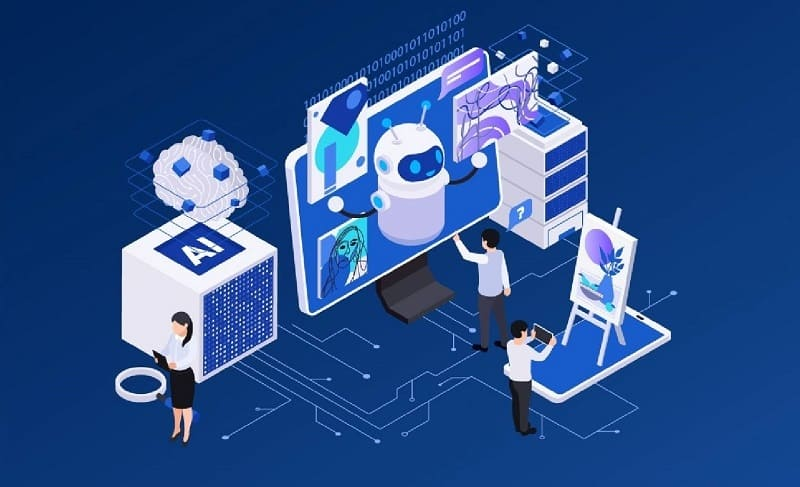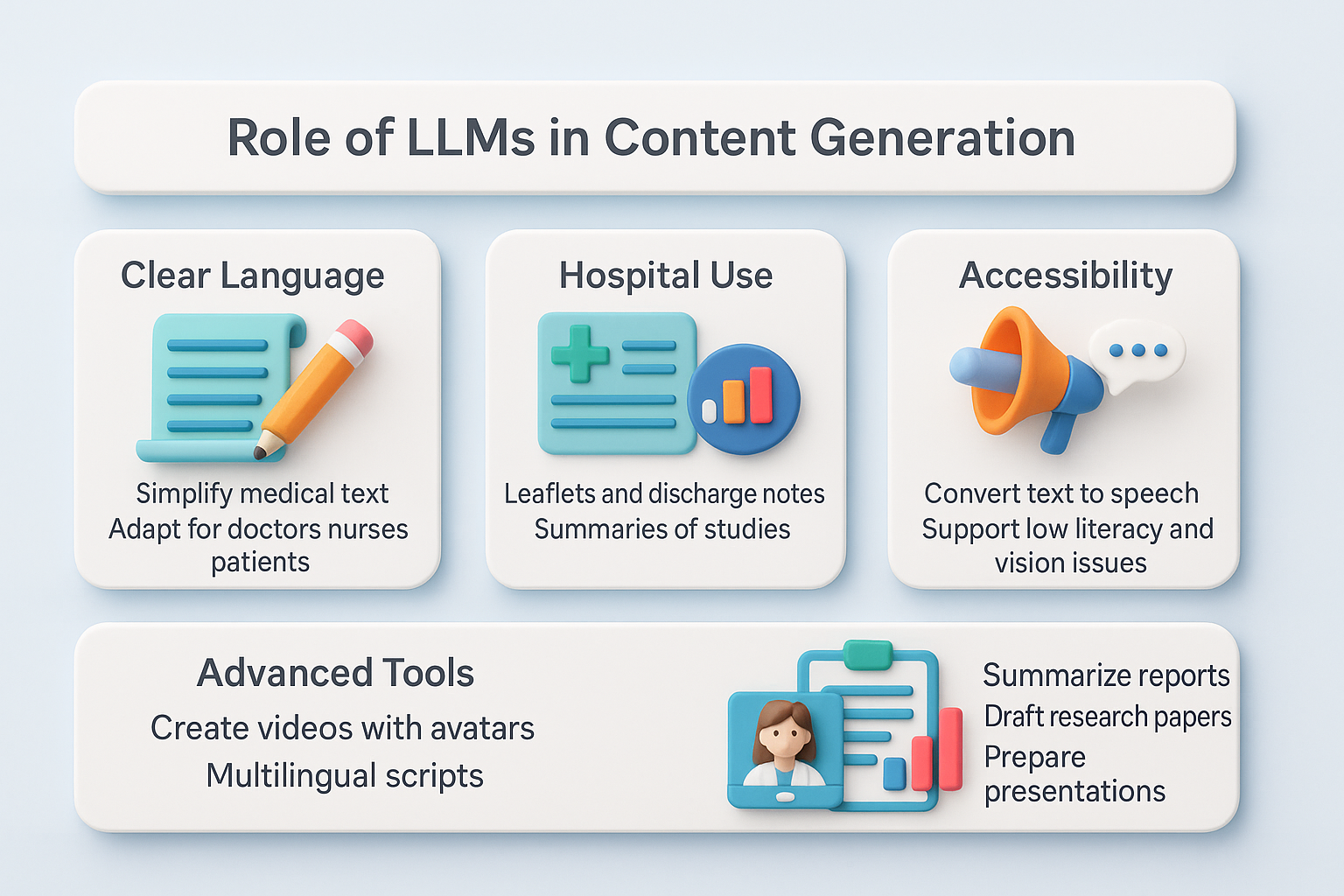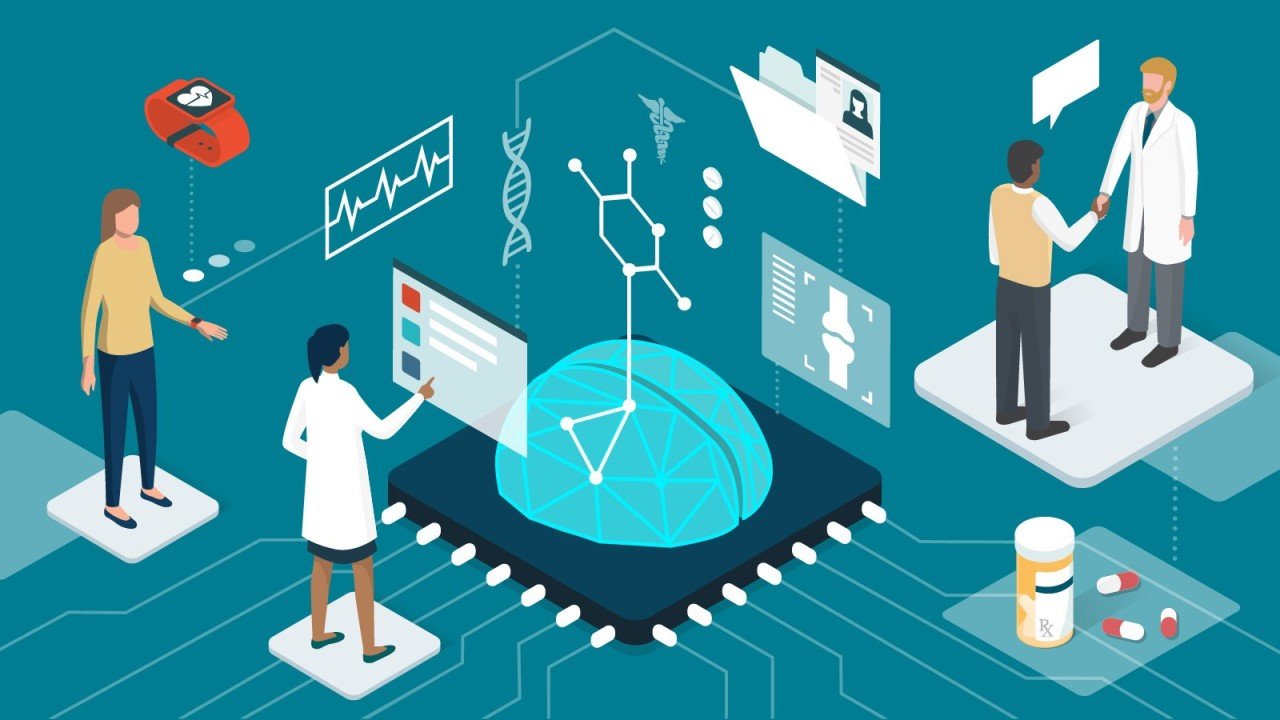Large language models (LLMs) are reshaping medicine faster than most expected. They move beyond text generation and enter real clinical practice. Hospitals, research labs and patient services already test them in daily work. Doctors use them to draft notes. Researchers scan thousands of studies. Patients receive instant answers through chat systems.
Their main strength is speed and scale. LLMs process medical text in seconds instead of hours. At the same time they raise critical risks. Bias, privacy concerns and safety questions remain open. Understanding both opportunities and dangers is essential before using them in healthcare.

What Are Large Language Models?
Large language models are advanced AI systems trained on enormous datasets of text. They rely on deep learning techniques, specifically transformer architectures, to detect patterns in language. In simple terms, they learn by analyzing billions of words, predicting the next word in a sequence, and gradually building a strong understanding of context and meaning.
The training process involves vast computational resources. Models like GPT or BERT require specialized hardware and months of processing on text drawn from books, scientific articles, clinical reports, and online data. The scale is what makes them powerful. For example, GPT-4 has been trained on trillions of parameters, allowing it to generate responses that often feel natural and accurate.
Different types of LLMs serve different goals. GPT is generative, producing new text for content creation or patient communication. BERT is designed to understand language, making it useful for search tools in electronic health records. T5 combines analysis and generation, making it valuable for translation tasks such as converting clinical notes into multiple languages. Multimodal models go a step further, working with both text and images — something critical for medical imaging and radiology.
Benefits of Large Language Models
The benefits of LLMs can be grouped into four main areas: efficiency, scalability, personalization, and innovation. These may sound broad, but in practice they translate into clear advantages in medicine, education, and research.
Efficiency is about saving time and resources. LLMs can automate repetitive tasks like drafting medical reports, summarizing patient histories, or generating translations of clinical documents. Instead of spending hours on documentation, doctors can focus on direct patient care. According to JAMA, AI-driven text support could reduce documentation time by up to 30 %.
Scalability means handling large volumes of data and requests at once. A hospital system with thousands of patients can use an LLM to manage records and support queries from both staff and patients. This level of automation is impossible to achieve with human staff alone.
Personalization is increasingly important in patient care. LLMs can tailor educational material, generate discharge instructions in plain language, and adapt recommendations to the patient’s age, condition, or literacy level.
Innovation comes from opening new research pathways. By scanning millions of scientific publications, LLMs can suggest new connections between genes, drugs, and diseases. The Gartner research on LLMs emphasizes how these models enable new forms of medical research that were previously unfeasible.
Types of Large Language Models
LLMs are not a single technology but a family of different architectures. Understanding their types helps explain why some are better suited for healthcare while others fit content creation or customer service.
- Generative Models. These models, such as GPT, create new text from scratch. In medicine, they are used for drafting clinical documentation, generating patient letters, or even assisting in research paper writing.
- Encoder-Only Models. BERT is the prime example. These models specialize in analyzing and classifying text. They are used for medical coding, literature search, or mining electronic health records for patterns.
- Encoder-Decoder Models. T5 is the standard here. These models can both understand and generate language, making them ideal for translation tasks. In medicine, this supports communication across languages in international trials or global patient care.
- Multimodal Models. These process text, images, and sometimes audio. They are crucial for radiology, where a model can analyze an X-ray and then generate a textual explanation.

As Forbes explains, each type represents a different layer of technological capability. Choosing the right model is not only a technical decision but also a matter of clinical safety.
Use Cases of Large Language Models
The impact of large language models is most visible when we look at their real applications. Healthcare, education, and customer service are early leaders, but the scope is wider and still expanding. These models are already embedded into workflows that deal with sensitive data and critical decisions.
Healthcare
LLMs automate routine yet time-consuming tasks such as clinical notes, discharge summaries, and translation of patient records into different languages. They also assist doctors in diagnostic reasoning by scanning scientific literature and highlighting possible conditions that match complex symptoms. In radiology, LLMs combined with image-analysis systems can generate written reports that help clinicians interpret scans faster. According to NIH findings, early pilots show that documentation time can be reduced significantly while maintaining accuracy. Some hospitals are even experimenting with models to draft informed consent forms in plain language to ensure patients understand medical procedures.
Education
Medical schools and teaching hospitals integrate LLMs into adaptive learning platforms. These systems deliver personalized tutoring for anatomy, pharmacology, or pathology based on a student’s strengths and weaknesses. An LLM can generate new exam questions that match the learner’s level, create flashcards, or simulate patient cases for training. There are also projects where LLMs help students practice clinical interviews by simulating realistic patient responses, offering immediate feedback on communication style and medical reasoning.
Customer Service
Hospitals, clinics, and insurance providers increasingly rely on AI-driven chatbots to answer patient questions. These chat systems handle tasks such as scheduling, billing, or explaining test results in clear terms. Advanced systems integrate with electronic health records, so a patient can ask about lab results and get context-specific explanations. This approach saves time for staff and reduces frustration for patients who might otherwise wait on hold for hours. Some insurers are already experimenting with multilingual support, enabling patients to ask questions in their native language.
Content Creation
Public health institutions use LLMs to draft articles, guidelines, and patient leaflets. The advantage is not only speed but also adaptability: a single guideline can be rewritten in multiple reading levels, making it understandable for both medical professionals and the general public. Research teams use models to summarize long clinical trials into digestible briefs for policymakers. In addition, LLMs support medical marketing departments in hospitals, helping them create social media content that communicates health advice responsibly and clearly.
Programming and Research
In bioinformatics, researchers apply LLMs to generate and debug code for genomic studies, which often involve highly complex pipelines. LLMs can propose optimized scripts for analyzing DNA sequences or protein structures. They can also automate tedious formatting of large datasets to prepare them for analysis. Some labs connect LLMs with laboratory equipment to produce semi-automated experiment protocols, ensuring consistency across research teams. Beyond bioinformatics, models are used to classify and cluster medical literature, enabling scientists to keep up with the tens of thousands of new papers published every year.

How LLMs Are Transforming Customer Support
For many patients, customer support is the first real interaction with a healthcare system. The quality of this first contact shapes trust and satisfaction. Large language models are now transforming this space.
Practical roles of LLM chatbots
LLM-powered chatbots can do much more than answer simple questions. They guide patients through pre-visit checklists, help them understand insurance coverage, and explain preparation steps for lab tests or surgeries. Some systems are trained to recognize when a case is too complex and escalate it to human staff. This ensures that patients receive reliable information without delays.
Efficiency in hospitals and clinics
Hospitals are under constant pressure to handle large volumes of calls and messages. LLM-driven conversational systems can respond instantly to thousands of patients at once. For example, a chatbot can book appointments, confirm schedules, and even suggest follow-up reminders based on patient history. This saves staff hours of routine work every week and helps reduce burnout. Studies show that AI-enabled triage can cut waiting times by more than 40 % in busy outpatient clinics.
Improving patient experience
Patients often struggle with medical jargon. LLMs can translate technical terms into plain language, ensuring that people understand their diagnosis or instructions. This is especially valuable for older patients or those with limited health literacy. Some hospitals also test multilingual chat systems, enabling patients to interact in their native language and reducing miscommunication.
Advanced use cases
There are experimental projects where chatbots use medical records to provide tailored guidance. For instance, after a patient’s lab results are uploaded, the chatbot can offer context, explain which values are normal, and suggest scheduling a follow-up. While this does not replace a doctor’s advice, it helps patients prepare better for consultations. Another area of interest is integrating LLMs with wearable devices. A patient could ask the chatbot why their heart rate spiked overnight, and the system could combine wearable data with medical guidelines to provide a safe, informed response.
Platforms in practice
Healthcare organizations are already testing scalable solutions like the Graphlogic Generative AI & Conversational Platform. Such platforms are designed to process thousands of patient interactions every day while maintaining a consistent and professional tone. They not only reduce waiting times but also allow human staff to focus on urgent or complex cases that need empathy and judgment. In addition, some clinics combine LLM chat systems with the Graphlogic Text-to-Speech API, giving patients the option to receive spoken instructions rather than only written ones. This is especially useful for visually impaired patients and those who prefer auditory learning.

The Role of LLMs in Content Generation
Medical content is often dense, full of technical language, and difficult for patients to understand. Large language models help bridge this gap by drafting texts in clear and accessible language. Instead of relying solely on medical jargon, LLMs can adapt the same information to different reading levels. This means the same clinical guideline can be presented in one version for doctors, another for nurses, and yet another simplified for patients and their families.
Practical applications in hospitals and research centers
Hospitals use LLMs to generate patient leaflets, pre-surgery preparation instructions, and discharge summaries written in plain terms. Research teams rely on them to create structured abstracts from long clinical studies, making it easier for policy makers or practitioners to digest new findings. Some public health agencies already apply LLMs to rewrite scientific papers into outreach materials for communities, which improves trust and comprehension.
Improving accessibility with voice technologies
Text generation becomes more powerful when combined with speech. Patients with low literacy or visual impairments can benefit from health information read aloud in natural-sounding voices. This is where solutions like the Graphlogic Text-to-Speech API play a role, turning AI-generated medical guidance into audio form. Hospitals experimenting with this approach report higher satisfaction among elderly patients who prefer listening over reading.
Advanced scenarios in medical communication
Some clinics combine generative AI with avatar systems to create educational videos that explain chronic conditions. Instead of long brochures, patients watch short clips generated automatically from verified medical sources. Platforms like the Graphlogic Generative AI & Conversational Platform are being tested to support this workflow. They allow staff to quickly create scripts, which are then turned into multilingual voice or video content. This saves time for medical educators and ensures consistency across different departments.
Support for medical professionals
Content generation is not limited to patients. Doctors use LLMs to create slide decks for conferences, summarize multi-page lab reports into concise notes, and prepare drafts of research papers. In settings where English is not the native language, models can produce publication-ready text, helping researchers share their findings globally. This accelerates the cycle of knowledge exchange and lowers the barriers for scientists working outside major research hubs.

Challenges of Using Large Language Models
The use of LLMs is not without risks. Four major challenges must be addressed before large-scale deployment in healthcare.
| Issue / Risk | Description |
| Bias and Fairness | Models may reflect biases from training data, which can harm the quality of patient care. |
| Data Privacy | Handling sensitive medical records requires strict safeguards. |
| Cost and Complexity | Training and deploying models require infrastructure that many hospitals cannot afford. |
| Ethical Concerns | There is a real threat of misinformation or misuse of generated content. |
The Stanford AI Index stresses the need for clear regulation and monitoring of these risks.
The Future of Large Language Models
Large language models are moving toward greater specialization and safer use in healthcare. Their role will be to support professionals, not replace them.
Complex conversations with patients
Future LLMs will manage longer, multi-turn dialogues without losing context. They may also detect emotional cues in text, making digital consultations more natural and supportive.
Integration with IoT and wearables
Wearables produce constant streams of health data. Next-generation LLMs will combine these signals with medical guidelines to explain trends and provide early warnings, supporting preventive care.
Customization for medical specialties
General-purpose models are too broad for oncology or cardiology. Specialized LLMs trained on focused datasets will assist with interpreting ECGs, reviewing imaging, or summarizing treatment protocols.
Hybrid systems
The future is not full automation but partnership. Doctors will use LLMs to draft notes, analyze data, and propose options, while retaining full responsibility for decisions. Platforms that link generative AI with secure records are already in testing.
Outlook
Multimodal tools will likely dominate, combining text, speech, and image analysis. A doctor could upload an MRI and receive a written report, while patients get explanations in text and audio via solutions like the Graphlogic Text-to-Speech API. These steps show how LLMs could become standard assistants in modern medicine.

Key Points to Remember About Large Language Models
- LLMs are trained on massive datasets and can simulate natural language.
- They improve efficiency, scalability, personalization, and innovation in healthcare.
- There are four main types: generative, encoder-only, encoder-decoder, and multimodal.
- Use cases range from healthcare and education to programming and customer service.
Challenges include bias, privacy, costs, and ethical misuse.
FAQ
They are AI systems trained to understand and generate human-like text.
They use deep learning to analyze vast amounts of text and predict patterns.
They increase efficiency, scale operations, and create more personalized services.
Healthcare, education, customer service, content production, and research.
Bias, data privacy issues, high costs, and potential misuse.

